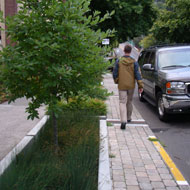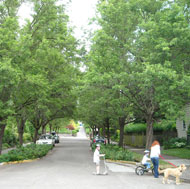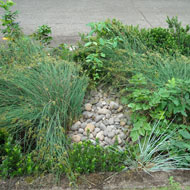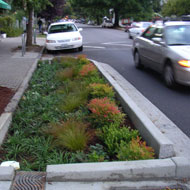Background
Portland is a leader in using strategies that manage storm water runoff, enhance community and neighborhood livability, and strengthen the local economy. A street that uses vegetated facilities to manage storm water runoff at its source is referred to as a Green Street. A Green Street is a sustainable storm water strategy that meets regulatory compliance and resource protection goals by using a natural systems approach to manage storm water, reduce flows, improve water quality and enhance watershed health.
In April 2007, the Portland City Council approved a Green Street resolution, report, and policy to promote and incorporate the use of Green Street facilities in public and private development.
The council recognizes that a comprehensive Green Street approach is an important development strategy to:
- Reduce polluted storm water entering Portland’s rivers and streams.
- Improve pedestrian and bicycle safety.
- Divert storm water from the sewer system and reduce basement flooding, sewer backups and combined sewer overflows (CSOs) to the Willamette River.
- Reduce impervious surface so storm water can infiltrate to recharge groundwater and surface water.
- Increase urban green space.
- Improve air quality and reduce air temperatures.
- Reduce demand on the city’s sewer collection system and the cost of constructing expensive pipe systems.
- Address requirements of federal and state regulations to protect public health and to restore and protect watershed health.
- Increase opportunities for industry professionals.
Adopted from: Portland Green Street Program
A critical piece of the City’s pioneering effort on green streets is public education. The City uses signage, tours, art displays, workshops, meetings, newsletters, fact sheets, fun outreach tools and events, and school lessons and tours. The city also encourages private participation in the development and implementation of the Green Street solutions.
Green Street Guiding Principles
- Manage storm water runoff both at the source and the surface.
- Use plants and soil to slow, filter, cleanse, and infiltrate runoff.
- Design facilities that aesthetically enhance the community.
Types of Green Streets
- Storm water curb extension: Extending into the street, storm water curb extensions transform the curb lane into a landscape area. Curb extensions can conveniently integrate a ramp for safe pedestrian crossing.
- Storm water street planter: Storm water street planters between the sidewalk and the curb work well in areas with limited space, and they allow for adjacent street parking or travel.
- Rain gardens: Where there is plenty of space, rain gardens are ideal. They can also transform awkward street intersections into safe pedestrian and bicycle crossings.
- Simple Green Street: Excavating an existing planting area behind a reinforced curb, making curb cuts for inflow and outflow, and landscaping with appropriate vegetation is a simple approach to capture and treat street runoff.
- Green Streets tour: Green Streets are implemented all around the city. The illustration below show detail plans (City of Portland).
- Portland State University street planters: Managing storm water runoff from the street through vegetated planters for flow and water quality benefit.
- NE 35th Place and Siskiyou Street curb extension swales: A green street retrofiw, which manages storm water at the source through a vegetated swale, while enhancing the neighborhood.
- NE 313st Avenue and Fremont Street landscaped curb extension: This argay Neighborhood site was retrofitted with a curb extension to manage street runoff.
- Glencoe Elementary School rain garden: BES and Portland Public Schools worked in partnership on this project.
- SE Division Street New Seasons Market: Landscape planters in sidewalk area take street runoff while beautifying a commercial/retail zone.
- Westmoreland permeable pavement project:
- N Gay Avenue porous pavement pilot project: pervious asphalt
Planting Design Guidelines (Text and photos from City of Portland):
- Grasses: A massed planting design that emphasizes the fine textures, year-round structure and color variation of grasses. The deciduous trees and shrubs add more fall color (e.g., California Grey Rush, Dwarf Redtwig Dogwood, Creeping Bramble, Orange Sedge).
- Shady woodland: An informally arranged planting design using native and ornamental plants (e.g., California Grey Rush, Blue Oat Grass, Boxleaf Euonymus, Sword Fern, Creeping Oregon Grape, Daffodil).
- Blooming garden: For a more formal, manicured neighborhood setting. The plants are tidy and compact with an emphasis on year-round flower and foliage color. Full sun (e.g., California Grey Rush, Heavenly Bamboo, Little Rascal Holly, Magic Carpet Spirea).
- Full gold garden: A design that emphasizes year-round structure and color variation of grasses, with a splash of pink flowers in summer. The deciduous trees add fall color. Full sun to partial shade (e.g., California Grey Rush, Gold Fountains Sedge, Gold Flame Spirea).
- Single species: Narrow, flat-bottom facilities are planted with a single species due to limited space. This creates year-round interest with a bold, simple design of color and texture (e.g., Ice Dance Sedge, Gold Fountains Sedge, California Grey Rush, Slough Sedge, Orange Sedge).
- Do not plant where vegetation will impede flow into the facility. For example, do not plant directly in front of curb openings, and take care when planting next to the edges where runoff sheet flows into the facility. Consider growth and spread of groundcover over time to reduce potential of blocking inlets.
- Dense plantings at the time of construction are recommended to:
- Provide immediate facility function, e.g. slow and detain storm water flow. trap sediments, and infiltrate storm water.
- Reduce soil erosion.
- Limit weed growth.
- Shade the soil and reduce evaporation.
- Planting a row of juncus species behind the forebay can reduce the migration of sediment into the facility.
- Avoid planting in summer months to reduce transplant shock and excessive irrigation. Plant in fall or early spring after frost.
- New facilities will require more frequent maintenance to ensure plant vigor in the first two years after planting. Activities include regular irrigation during dry summer months, controlling weeds before they become established, debris removal, and occasional mulching.
- Overhead spray irrigation systems can encourage weed growth, given the right conditions, by wetting the entire area. Drip irrigation systems appear to be better alternatives to control water delivery directly to the selected plant.
- Concentrated sediment deposits, especially from street runoff, should be removed frequently so as not to create conditions that support germination of non-native or undesirable species and so deposits do not smother healthy plants. Frequency will depend on each site.
- Depending on the selection of plants and the particular constraints of a facility site, large rambling shrubs may require regular pruning or shearing to control their height and spread. This practice can increase vegetative growth.
- Provides clean air and water.
- Enhances neighborhood livability.
- Increases community and property values.
- Enhances pedestrian and bicycle access and safety.
- Protects valuable surface and groundwater resources.
- Adds urban green space and wildlife habitat.
- Helps meet regulatory requirements for pollutant reduction and watershed resource management.
- Reduces storm water in the sewer system.
- Saves money on wastewater pumping and treatment costs.
- Demonstrates that Green Streets can be applied to residential streets, commercial zones, school zones, and parking areas.
- Parking: Depending on the type of facility, parking space can be removed (e.g. curb extensions).
- Mosquitoes: Green Streets are designed to drain in less than 48 hours to prevent mosquito breeding, but continuous monitoring is necessary.
- Plant survival: Attention should be given to site characteristics, such as location, solar exposure, and soil type and condition, to provide optimum success for plant survival. To increase survival rates, vegetated facilities must receive proper and consistent irrigation and weed control, especially during the first two years of establishment.
- City codes: City codes can prohibit use of ornamentals in some areas, such as environmental and greenway zones. Even if native species require little irrigation and no pesticides or fertilizer, native species alone can limit plant diversity.
- Maintenance: The city needs to regularly monitor facilities. In Portland, Environmental Services maintains Green Streets. Also neighbors’ help is essential to keep the facilities free of litter and leaves.
Adpoted from: City of Portland
For more information visit: Green Streets
(http://www.portlandonline.com/bes/index.cfm?c=34602&)
Planting Approach
Maintenance
The type and frequency of short-term start up and long-term maintenance can affect plant vigor, growth habit, and facility aesthetics.
Adopted from: 2007 Vegetation Survey Report for Landscaped Storm water Management Facilities, City of Portland
Lessons Learned
Potential Benefits
Potential Issues
Adopted from : City of Portland Q&A: http://www.portlandonline.com/bes/index.cfm?c=45379&a=212485, and 2007 Vegetation Survey Report for Landscaped Storm water Management Facilities
Sources
City of Portland, “Portland Green Street Program” (http://www.portlandonline.com/BES/index.cfm?c=44407)
City of Portland, “2007 Vegetation Survey Report for Landscaped Storm water Management Facilities”
City of Portland, “Green Streets” (http://www.portlandonline.com/bes/index.cfm?c=34602&)
City of Portland, “Q&A” (http://www.portlandonline.com/bes/index.cfm?c=45379&a=212485)
Photo Sources
MIG, Inc.




